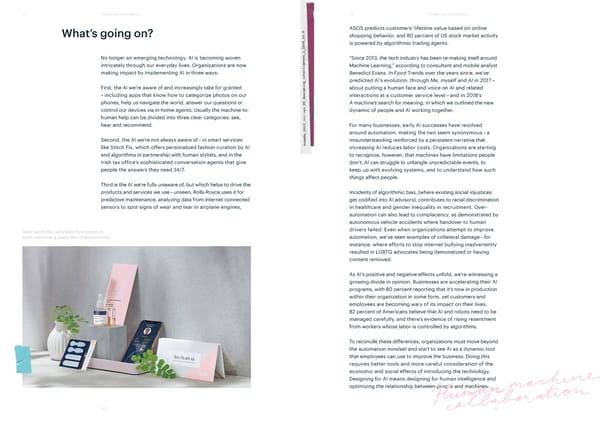T5 Designing intelligence T5 Designing intelligence What’s going on? ASOS predicts customers’ lifetime value based on online shopping behavior, and 80 percent of US stock market activity is powered by algorithmic trading agents. No longer an emerging technology, AI is becoming woven “Since 2013, the tech industry has been re-making itself around intricately through our everyday lives. Organizations are now Machine Learning,” according to consultant and mobile analyst making impact by implementing AI in three ways: Benedict Evans. In Fjord Trends over the years since, we’ve predicted AI’s evolution: through Me, myself and AI in 2017 – First, the AI we’re aware of and increasingly take for granted about putting a human face and voice on AI and related – including apps that know how to categorize photos on our interactions at a customer service level – and in 2018’s phones, help us navigate the world, answer our questions or A machine’s search for meaning, in which we outlined the new control our devices via in-home agents. Usually the machine-to- dynamic of people and AI working together. human help can be divided into three clear categories: see, hear and recommend. For many businesses, early AI successes have revolved around automation, making the two seem synonymous – a Second, the AI we’re not always aware of – in smart services misunderstanding reinforced by a persistent narrative that like Stitch Fix, which offers personalized fashion curation by AI increasing AI reduces labor costs. Organizations are starting and algorithms in partnership with human stylists, and in the to recognize, however, that machines have limitations people Irish tax office’s sophisticated conversation agents that give don’t: AI can struggle to untangle unpredictable events, to people the answers they need 24/7. keep up with evolving systems, and to understand how such things affect people. Third is the AI we’re fully unaware of, but which helps to drive the products and services we use – unseen. Rolls-Royce uses it for Incidents of algorithmic bias, (where existing social injustices predictive maintenance, analyzing data from internet-connected get codified into AI advisors), contributes to racial discrimination sensors to spot signs of wear and tear in airplane engines, in healthcare and gender inequality in recruitment. Over- automation can also lead to complacency, as demonstrated by autonomous vehicle accidents where handover to human Start-up Atolla calibrates face serum to drivers failed. Even when organizations attempt to improve each customer’s exact skin characteristics. automation, we’ve seen examples of collateral damage – for instance, where efforts to stop internet bullying inadvertently resulted in LGBTQ advocates being demonetized or having content removed. As AI’s positive and negative effects unfold, we’re witnessing a growing divide in opinion. Businesses are accelerating their AI programs, with 80 percent reporting that it’s now in production within their organization in some form, yet customers and employees are becoming wary of its impact on their lives. 82 percent of Americans believe that AI and robots need to be managed carefully, and there’s evidence of rising resentment from workers whose labor is controlled by algorithms. To reconcile these differences, organizations must move beyond the automation mindset and start to see AI as a dynamic tool that employees can use to improve the business. Doing this requires better tools and more careful consideration of the economic and social effects of introducing the technology. Designing for AI means designing for human intelligence and optimizing the relationship between people and machines. 65 66
 xReport Page 37 Page 39
xReport Page 37 Page 39